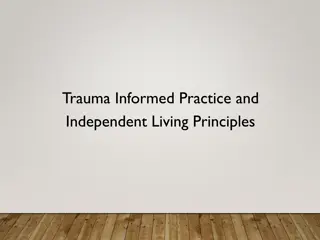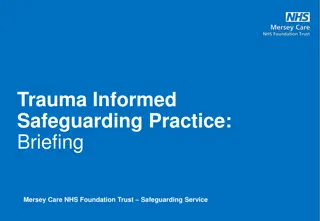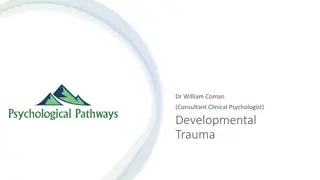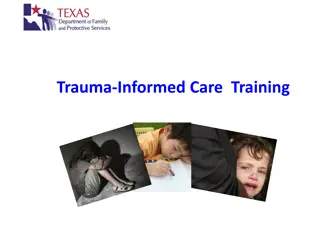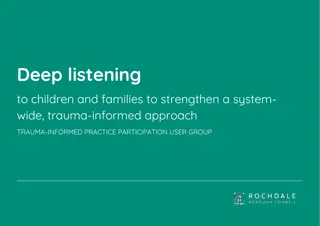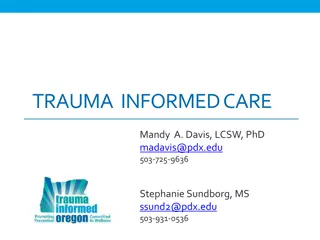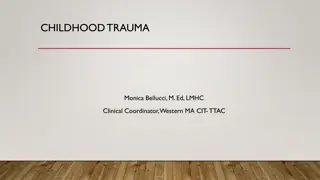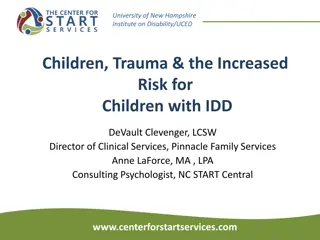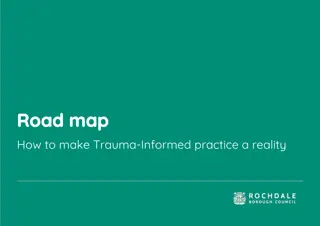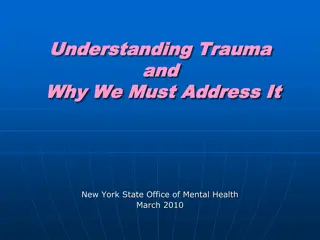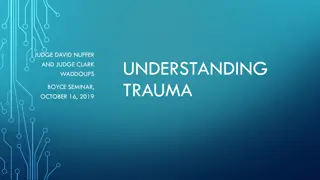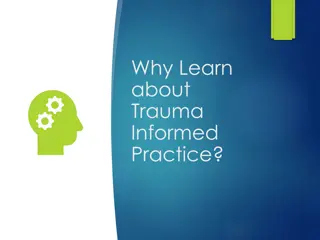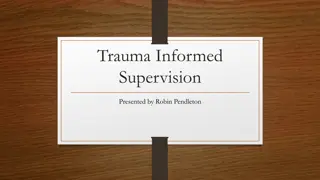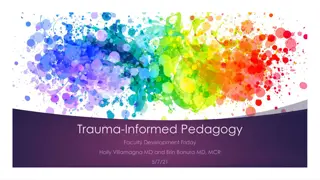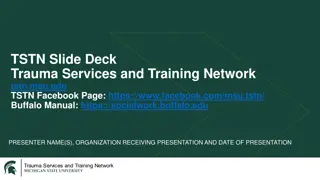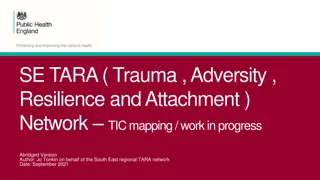Impact of Trauma on Children and the Importance of Trauma-Informed Systems
This content delves into the effects of trauma on children, addressing secondary traumatic stress and emphasizing the necessity of trauma-informed systems. It discusses the significance of understanding and implementing such systems in various settings to support traumatized individuals effectively.
Download Presentation

Please find below an Image/Link to download the presentation.
The content on the website is provided AS IS for your information and personal use only. It may not be sold, licensed, or shared on other websites without obtaining consent from the author.If you encounter any issues during the download, it is possible that the publisher has removed the file from their server.
You are allowed to download the files provided on this website for personal or commercial use, subject to the condition that they are used lawfully. All files are the property of their respective owners.
The content on the website is provided AS IS for your information and personal use only. It may not be sold, licensed, or shared on other websites without obtaining consent from the author.
E N D
Presentation Transcript
The Impact of Trauma on Children, Secondary Traumatic Stress & the Importance of Trauma-Informed Systems Richard N. Costa, Psy.D., MP Clinical Associate Professor of Psychiatry LSUHSC School of Medicine August 9, 2017 Psychiatry
Goals of Training To discern optimal mental health from the symptoms associated with traumatic stress To understand how challenging behaviors in youth are symptomatic of trauma/complex trauma exposure To recognize the signs of secondary traumatic stress/vicarious trauma To highlight characteristics of trauma-informed systems to serve traumatized clients and foster staff wellness Psychiatry
Ingredients for Optimal Social/Emotional Functioning Having encouraging teachers and caregivers Appropriate guidance and discipline Developmental sensitivity Unconditional love from families Self-confidence and adequate self-esteem Opportunity to play with other children Safe and secure environment Psychiatry
Basic Assumptions: Challenging Behavior Children show distress through challenging behavior Challenging behavior usually has a message- I am bored, I am sad, you hurt my feelings, I need some attention . Children often use challenging behavior when they don t have the social or communication skills they need to engage in more appropriate interactions. Behavior that persists over time serves a function for the child (challenge for us is figuring out what). The primary purpose of behavior is to be understood, not punished. We need to focus on teaching children what to do in place of the challenging behavior. http://csefel.vanderbilt.edu Psychiatry
Building Relationships is Key! Children learn and develop in the context of relationships that are responsive, consistent, and nurturing. Relationships that we build with children: are the foundation of everything we do are most important with challenging behaviors build empathy and mutual respect should be fostered early on rather than waiting until there is a problem. Every child needs one person who is crazy about him. -Uri Bronfenbrenner Psychiatry
What is Trauma? An exceptional experience in which powerful and dangerous stimuli overwhelm the child s capacity to regulate his or her affective state Witnessing or experiencing an event that poses a real or perceived threat to the life or well-being of the adolescent or someone close to him/her Psychiatry
Potentially Traumatic Experiences Physical abuse Sexual abuse Emotional abuse Witnessing domestic violence Abandonment or neglect The death or loss of a loved one Automobile accidents or other serious accidents Terrifying bullying Life-threatening health and/or painful medical procedures Exposure to community violence Witnessing police activity or having a close relative incarcerated Life-threatening natural disasters Acts or threats of terrorism Psychiatry
Being Trauma-Informed Trauma profoundly impacts behavior, emotional responses, forming relationships, and how kids view the world. Internalizing disorders are often undetected and most youth do not seek or receive treatment. Children bring their traumas to school! Psychiatry
Traumas can Impact School Performance Decreased reading ability Decreased school readiness Lower GPA Higher rate of school absences More suspensions and expulsions Increased drop-out Child Trauma Toolkit for Educators. October 2008. The National Child Traumatic Stress Network. www.NCTSN.org Psychiatry
Trauma can also affect: Child s ability to trust adults to keep him/her safe. Child s ability to learn Child s social & emotional development Child s ability to manage anger Child s ability to be a child Friendships/peer support Child s self esteem Psychiatry
The Cognitive Triangle (Complex Trauma) Emotions Thoughts Behaviors Psychiatry
Behaviors (Physical Symptoms) Hyperactive Clumsy Intrudes into personal space Fidgety Vague illnesses Headaches, stomachaches Physically reactive (aggressive) to touch Running away, bolting Psychiatry
Emotional Symptoms Angry outbursts Aggression Over-reactive Moody swings Bossy/controlling/demanding Shutting down Needy/clingy Cannot calm down without help Psychiatry
Thoughts (Cognitive Symptoms) Distracted Can t concentrate Slow to respond to questions Poor comprehension/retention Trouble talking about feelings/thoughts or explaining self Misunderstands others/misreads cues Zoning out Psychiatry
Factors that influence how children experience trauma The number and severity of the traumatic episodes Proximity to the event The personal significance of the traumatic event for the child The extent to which the child s support system is disrupted after the trauma 15 Psychiatry
Other Factors Child s age and developmental stage Child s perception of the danger faced Child s relationship to victim and/or perpetrator Presence/availability of adults who can offer help and protection Genetic predisposition Previous history of trauma experiences 16 Psychiatry
Vicarious Trauma, Secondary Traumatic Stress, & Compassion Fatigue refers to the cumulative effect of working with survivors of traumatic life events, or perpetrators, as part of everyday work. People who engage empathically with victims or survivors are particularly vulnerable burnout Psychiatry
Secondary Traumatic Stress (STS) Distress that results when an individual hears about the firsthand trauma experiences of another re-experiencing personal trauma or changes in memory/perception; depletion of personal resources; disruption in perception of safety, trust, independence. Psychiatry 18
Secondary Trauma (From Judge Michael Howard, Juvenile Judge in Ohio, 2009) Secondary trauma occurs when child serving systems re-traumatize a child through policies and procedures Examples: multiple placements; handcuffing parents in front of their children; visitation; change of caseworkers; court situations; detention centers; institutional trauma; foster care Psychiatry
Factors that Contribute to Risk Repeated exposure to trauma stories Empathic engagement with clients who may also be difficult to engage Measuring self-worth by how much you help others Unrealistic expectations of yourself and others Dealing with large bureaucracies Often there are no easy solutions or quick fixes Psychiatry
Additional Risk Factors A history of trauma and stressful life events that have not been addressed therapeutically Repeated exposure to the cruelty of other people. Increased awareness of the frequency of trauma and the harm of abuse and neglect. Inability to say no. Juggling work with home and family responsibilities Little self care Psychiatry
What is a Trauma-Informed Child and Family Service System? Systems that seek to resist re-traumatization of clients and staff Programs and agencies strive to infuse and sustain trauma awareness, knowledge and skills into organizational cultures, practices and policies Are mindful of best practices to maximize physical and emotional safety, facilitate recovery, and support ability to thrive (National Child Traumatic Stress Network, 2014) Psychiatry
Trauma-Informed Systems Regularly screen for trauma exposure & symptoms Use evidence-based, culturally sensitive assessment/treatment for traumatic stress Have resources on trauma exposure, impact, and tx Work to foster resilience and protective factors impacted Consider parent/caregiver trauma and its impact on family system Emphasized continuity of care and collaboration Supports staff, addresses STS, promotes staff wellness (National Child Traumatic Stress Network, 2017) Psychiatry
SUPPORT AND SELF-CARE Image result for teacher support Psychiatry
Self-Awareness Don t go at it alone Be honest with yourself about how you feel about the child Ask for help or support if you personally struggle with a student or are personally triggered by certain behaviors If you are experiencing a life stressor or acute period of stress be pro-active in asking for help Psychiatry
Prioritize Self-Care Compassion fatigue can be an occupational hazard- don t be afraid to seek professional help if you find yourself feeling overwhelmed by others trauma(s) Make time for the people and things you love outside of school or work; leave work at work! A healthy diet, adequate sleep, and exercise have a profound impact on mental health and well-being Make time for mindfulness- meditation, breathing exercises, adult coloring, yoga have been proven to lower stress levels Know your limits and when to say No Psychiatry





